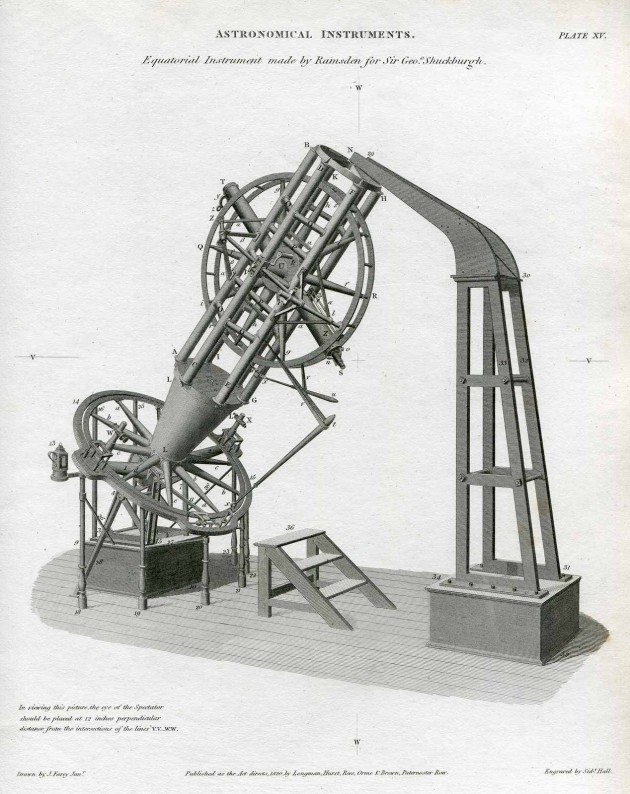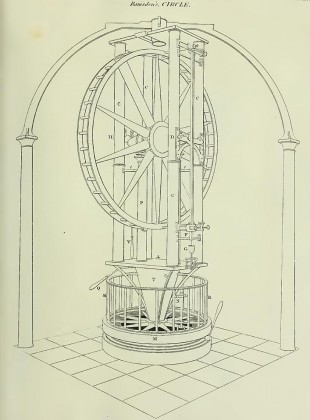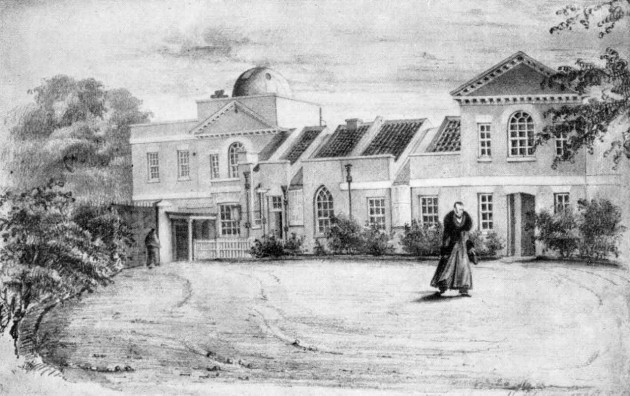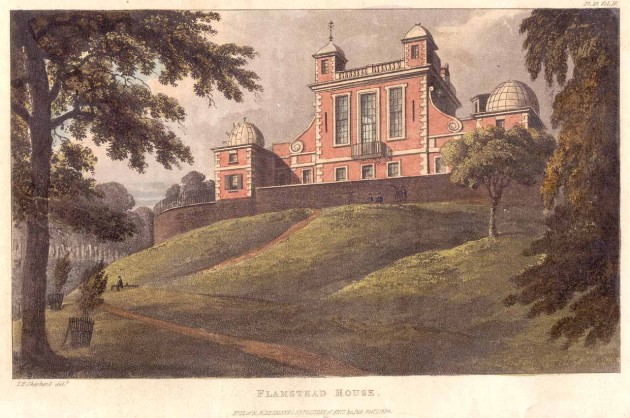…where east meets west
- Home
- Brief History
- The Greenwich Meridian
- Greenwich
(1675–1958) - Herstmonceux
(1948–1990) - Cambridge
(1990–1998) - Outstations (1822–1971)…
- – Chingford (1822–1924)
- – Deal
(1864–1927) - – Abinger
(1923–1957) - – Bristol & Bradford on Avon
(1939–1948) - – Bath
(1939–1949) - – Hartland
(1955–1967) - – Cape of Good Hope
(1959–1971)
- Administration…
- – Funding
- – Governance
- – Inventories
- – Pay
- – Regulations
- – Royal Warrants
- Contemporary Accounts
- People
- Publications
- Science
- Technology
- Telescopes
- Chronometers
- Clocks & Time
- Board of Longitude
- Libraries & Archives
- Visit
- Search
Telescope: Shuckburgh Equatorial (1791)
Also known as the Shuckburgh 4.1-inch Refractor and the five-feet equatorial, the Shuckburgh Equatorial was made by Jesse Ramsden for Sir George Shuckburgh in 1791 and mounted in his observatory at Shuckburgh, Warwickshire. Following his death in 1804 it was presented to the Royal Observatory in 1811 by his heir the Hon. Cecil Jenkinson (later Lord Liverpool). In 1929, the telescope was transferred to the Science Museum, London (RGO39/5/48) where it was restored and put on display (Object ID: 1929-979). Famous as the World’s first large equatorial telescope, it was never a great success. It suffered from many deficiencies which were cuttingly described by Pearson in 1829 who wrote: ‘the frame-work was found too slender for the length of the polar axis, and it remains at Greenwich, a proof of its former proprietor’s munificence rather than of its maker’s success in the strength and stability of its essential parts.’

The Shuckburgh Equatorial. Drawn by J Farey Junior and engraved by Sidney Hall, the plate is a re-drawing of the original published in Philosophical Transactions in 1793. From Rees's Cyclopaedia (London, 1820)
Dimensions and mounting
Mounted in a form that later became known as an English Equatorial, the telescope had an objective in the form of an achromatic doublet of 4.1-inches aperture. The telescope had a length of 5 feet 4 inches.
Early history
Ordered from Ramsden in 1781, the telescope took ten years to be delivered. It is thought to contain parts made by Ramsden, for an upgrade of one of the Sisson 5-foot Equatorial Sectors at Greenwich, that had been paid for in 1778 but never delivered. The telescope was used by Shuckburgh with an unusual degree clock by Arnold. Presented with the telescope to the Royal Observatory, the clock was transferred with it to the Science Museum in 1929 (Object ID: 1929-979 Pt2). According to Howse (Greenwich Observatory, London, 1975, p136), the clock was transferred to the National Maritime Museum (Object ID: ZAA0563) in 1967. The clock remains there on loan from the Science Museum.
Installation at Greenwich
The proposed gift of the telescope to the Royal Observatory was announced on 1811 at the Visitation of the Royal Observatroy by the President of the Royal Society (who by virtue of his position as President was also chairman of the Observatory’s Board of Visitors). The Visitors resolved to accept it and also to place upon it an inscription ‘for the purpose of recording Sir George Shuckburgh Evelyn’s skill in astronomy and the liberality of Mr Jenkinson’ (RS MS600/66 & RGO6/22/67–8). The instrument was subsequently received from Jenkinson by a committee appointed from the Visitors. It had been packed into cases by Matthew Berge (Ramsden’s former head workman who had taken over the business on his death in 1800).
It was only at this point that the Board of Ordnance was asked by the Visitors to take the cases from there to Greenwich and to adopt any ‘such measures as may be necessary in order that it may be erected in the most advantageous manner for making astronomical observations consistently with the wish expressed by the Donor that no alteration should be made in the Instrument which should permanently render it unfit for the purpose of being employed as an equatorial as originally intended.’ (RGO6/22/73)

The Palermo Circle. Note: two of the four steel uprights have been omitted from the drawing for clarity. From Rees's Cyclopaedia (London, 1820)
Little seems to be recorded about what happened next, but on 8 July 1813 the foundation stone of a new building was laid. This was effectively an extension tacked on to the east end of what is now called the Meridian Building. As well as a dome for the telescope, it also contained new accommodation for the First Assistant. The new extension could only be accessed from the outside, not from the existing building – a situation that remained until the late 1840s. A conical pier was erected (just a few metres to the east of the recently installed Mural Circle by Troughton), with the aim or erecting the telescope upon it not as an equatorial, but as an altitude and azimuth (altazimuth) instrument. To achieve this, it was arranged to mount the polar axis vertically and support its upper pivot by an arched frame carried on four pillars, similar to that of the Palermo Circle (which Ramsden had also made). The pillars were based, apparently by merely screwing, upon a four-armed iron cross (which Airy records as still being in existence in 1863), with just its centre imbedded in the pier. Upon trying the mounting, it was found so unsteady, that the instrument was never erected there at all.
The new dome, (which subsequently became known as the South-East Dome), remained empty from that time until the erection of Sheepshanks Equatorial there in 1838.

The Meridian Building with the dome constructed for the Shuckburgh Equatorial. From a drawing by Elizabeth Smith, 11 February 1839
How much was known about the equatorial’s defects before it came to Greenwich is unclear. If the weakness of the polar axis was known, it might explain why it was proposed to mount the telescope as an altazimuth in apparent disregard of Jenkinson’s wishes. We do not seem to know if it was the Visitors or John Pond who decided to mount it as an altazimuth, nor do we seem to know who was commissioned to provide the iron framework to support it.
The telescope was eventually erected by Berge in June 1816. Mounted not as an altazimuth but as an equatorial as originally designed, it was placed in the eastern of Flamsteed’s two former summerhouses, in place of the Sisson Equatorial Sector that had previously been erected there. When originally converted into domes, each of the summerhouses had held an equatorial sector, so that between them, the whole sky could by observed. For the new instrument, the location was appalling as much of the western sky was obscured from view by the looming bulk of Flamsteed House immediately to the west.

From 1816 until 1929, the Shuckburgh Equatorial was housed in the dome on the left. Originally Flamsteed's Eastern Summerhouse, it became known as the East Dome following its conversion to house a telescope in 1773. Under Airy, it became known first as the North-East Dome and then as the North Dome. Flamsteed House. Drawn by TH Shepherd and published on 1 October 1824 by R Ackermann in his Repository of Arts, Literature, Fashions &c..
Alterations to the iron frame supporting the polar axis
At some point, the iron frame supporting the polar axis was replaced with one mainly made of stone. This can be seen by comparing the image above with an image of the telescope at the Science Museum (click here for image). The question therefore arises as to when and why this was done. Was the change made when it arrived at Greenwich or when it arrived at the Science Museum … or perhaps even by Shuckburgh himself? Regrettably, there is only one known image of the telescope in the dome at Greenwich. This is very rudimentary and appears in a cross section of Flamsteed House drawn by Airy in 1846 (ADM140/426). It does not allow any firm conclusions to be drawn.
In his account of the telescope (see below), Airy makes no mention of the frame having been replaced when it was installed at Greenwich. Howse (1975, fig.80) on the other hand states it was mounted in its modified form at Greenwich, but regrettably cites no sources. If it was modified for use at Greenwich, one can only speculate as to the reason why. Here are three plausible explanations.
- It may have been an attempt to make the telescope more stable.
- The original iron frame may have been discarded when the decision was made early on to mount the telescope as an Altazimuth.
- Modification was required to enable the instrument to be mounted on the existing stone piers within the dome.
Usage
The first published observations seems to have been of the solar eclipse that occured on 4 May 1818. (Click here to view). In Pond’s time, the telescope was little used. When it was, it was often in conjunction with the Western Equatorial which was cobbled together in about 1824 and occupied the other summerhouse. The main objects observed seem to have been comets, solar eclipses and immersions and emersions of the satellites of Jupiter. It was superseded as the Observatory’s main equatorial instrument by the Sheepshanks Equatorial which came into use in 1838. Its importance diminished further when the 12.8-inch Merz refractor on its equatorial mounting came into use in 1860. The Shuckburgh continued however to be maintained by Airy for the ‘observation of occasional phenomena’. In the 1882 report to the Board of Visitors, it is described as being ‘kept in tolerable repair’. With the arrival of the Lassell Telescope in 1883, it appears to have fallen out of use completely.
Clocks
Although Shuckburgh had used the telescope with the degree clock by Arnold, at Greenwich it was used with the clock already in the dome where it was installed. Made by Arnold, it was described in the pre 1835 inventories as ‘A month clock, with compound pendulum and Ruby Pallets’. Since 1835, the clock has been known as ‘Arnold 1’. In later years, Arnold 1 was upgraded and ocassionally used in other locations.
Re-divisions of the circles
In 1838/9, the divisions on the declination circle (which had become ‘so much effaced as render it in parts useless’) were re-divided by William Simms. In 1860, the hour circle was similarly re-divided by his son James Simms.
Airy’s description of the instrument
A brief description was published in the introduction of each of the editions of Greenwich Observations from 1836 to 1908. The text below is from the 1860 volume and is longer than those of the early and much later volumes. Click here to read it as originally published.
‘This instrument was the property of Sir George Shuckburgh, and is fully described by him in the Philosophical Transactions for 1793. It was presented to the Observatory in the year 1811. It was intended to be mounted in what is now called the East Dome, as an Altitude and Azimuth Instrument; but its mounting (similar to that of the Palermo Circle) was found so unsteady that it was never once used; and it was then mounted as an Equatoreal in the North Dome (formerly called the North-Eastern Dome), where it has since remained. The situation of this dome is most unfavourable, as the South-Western sky, to the altitude of 35º, and a considerable horizontal extent to the altitude of 53º, is concealed by the Octagon Room. The position of the instrument is 52 feet West and 90 feet North of the old Transit Instrument, or 71 feet West and 97½ feet North of the new Transit-Circle. The Equatoreal one of that class in which the two pivots of the polar axis are at the two extremities of the polar axis, and the two pivots of the declination-axis are at the two extremities of the declination-axis: the telescope and declination circle being between the pivots of the declination-axis, and the declination-axis being within the frame of the polar axis, and the complete polar axis and hour-circle being between the polar supports. The whole length of the polar axis, between the extremities of the pivots, is about 9 feet. These pivots turn in Y’s (having proper adjustments), which are carried by two piers on opposite sides of the Dome. The North pivot is at the center of a circular frame; the South pivot is at the apex of a cone; and the polar frame consists of six pillars, connecting the base of this cone with the circular frame. Three pillars are united by intervening bars to form the eastern side of the polar frame, and three to form the western side: they carry the Y’s for the declination-axis, and the microscopes for reading the declination-circle. The length of the declination-axis between the extremities of its pivots is about 2 feet 2 inches: the diameter of the declination-circle is 4 feet, and the circle is divided to 5’ of arc. The telescope is 5 feet 4 inches in length, and has an object-glass of 4.1 inches aperture. The hour-circle is connected with the cone; its diameter is 4 feet, and it is divided to 10’ of arc: these divisions are read by fixed micrometer-microscopes. The graduations of the hour-circle had become very indistinct, and the circle was therefore redivided by Mr. James Simms in the month of November, 1860.’
Contemporary Accounts
An Account of the Equatorial Instrument. By Sir George Shuckburgh, Bart. F. R. S. George Shuckburgh, Phil. Trans. R. Soc. Lond. 1 January 1793 vol. 83 pp.67–128
Rees’s Cyclopædia in 39 Volumes.
Description: Volume 13, (London, 1819), Sir George Shuckburgh’s fixed equatorial instrument
Plate: Plates Volume 1, (London, 1820), Astronomical Plate XV
The plate at the top of this page comes from this account. A key together with a full description is contained in the description in Volume 13 to which a link is given above.
Further Reading
The Palermo Circle from Rees’s Cyclopædia in 39 Volumes.
Description: Volume 8, (London, 1819), Astronomical Circle by the late Jesse Ramsden
Plate: Plates Volume 1, (London, 1820), Astronomical Plate V
Jesse Ramsden (1735–1800), London’s Leading Scientific Instrument Maker. Anita McConnell, Ashgate Publishing, 2007
© 2014 – 2026 Graham Dolan
Except where indicated, all text and images are the copyright of Graham Dolan